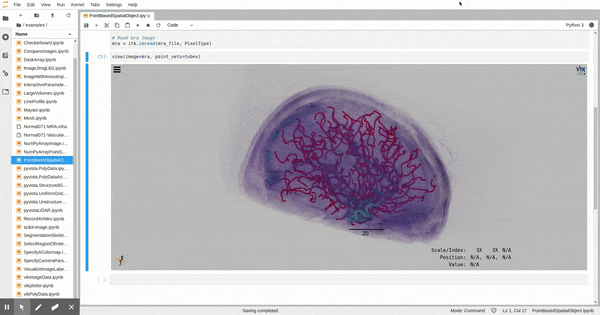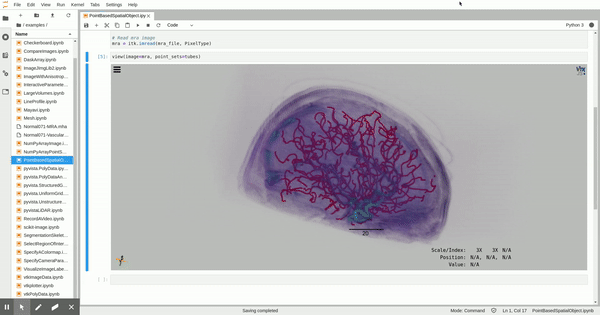ITK 5.1 Release Candidate 3 available for download

We are happy to announce the Insight Toolkit (ITK) 5.1 Release Candidate 3 is available for testing! :tada: ITK is an open-source, cross-platform toolkit for N-dimensional scientific image processing, segmentation, and registration.
ITK 5.1 is a feature release that improves and extends the major ITK 5.0 release. ITK 5.1 includes a NumPy and Xarray filter interface, clang-format enforced coding style, enhanced modern C++ range support, strongly-typed enum’s, and much more.
Release Candidate 3 adds a remote module rating quality grading system, a new remote module, TubeTK, and improvements based on experience with Release Candidate 2.
Downloads
Python Packages
Install ITK pre-release binary Python packages with:
pip install --pre itkLibrary Sources
Testing Data
Unpack optional testing data in the same directory where the Library Source is unpacked.
Checksums
Features

Brain vessels segmented with the new TubeTK remote module. To install experimental Python packages: pip install itk-tubetk. Jupyter notebooks are provided as examples.
Pass NumPy Array’s or Xarray DataArray’s to ITK Image Filters
The Pythonic, functional-like interface to all ITK image-to-image-filters now directly supports operation on NumPy ndarray’s, i.e. numpy.ndarray. If a ndarray is passed as an input, a ndarray is returned as an output.
For example,
smoothed = itk.median_image_filter(array, radius=2)Previously, explicit conversion to / from an itk.Image was required with itk.array_from_image and itk.image_from_array.
We can now also convert an itk.Image to a numpy.ndarray with the standard np.asarray call.
import numpy as np
import itk
image = itk.imread('/path/to/image.tif')
array = np.asarray(image)Similar, experimental support (subject to change) is also available for Xarray DataArray’s. If an xarray.DataArray is passed as an input, an xarray.DataArray is returned as an output. Moreover, the operation preserves spatial and dimensional metadata. For example,
import xarray as xr
import itk
image = itk.imread('/path/to/image.tif')
da = itk.xarray_from_image(image)
smoothed = itk.median_image_filter(da, radius=3)
print(smoothed)results in:
<xarray.DataArray (y: 288, x: 894)>
array([[255. , 255. , 255. , ..., 255. , 255. , 255. ],
[ 11.9995, 11.9995, 11.9995, ..., 11.9995, 11.9995, 11.9995],
[ 11.9995, 11.9995, 11.9995, ..., 11.9995, 11.9995, 11.9995],
...,
[ 11.9995, 11.9995, 11.9995, ..., 11.9995, 11.9995, 11.9995],
[ 11.9995, 11.9995, 11.9995, ..., 11.9995, 11.9995, 11.9995],
[ 11.9995, 11.9995, 11.9995, ..., 11.9995, 11.9995, 11.9995]],
dtype=float32)
Coordinates:
* x (x) float64 0.0 1.0 2.0 3.0 4.0 ... 889.0 890.0 891.0 892.0 893.0
* y (y) float64 0.0 1.0 2.0 3.0 4.0 ... 283.0 284.0 285.0 286.0 287.0
Attributes:
direction: [[1. 0.]\n [0. 1.]]A round trip is possible with itk.image_from_xarray.
Python 3 Only
ITK 5.1 will be the first Python 3-only release. Consistent with most scientific Python packages and CPython’s 2020 drop in support, Python 2 support and binaries are no longer be available.
Python Package 64-bit Float Support
In addition to the many other pixel types supported, the itk binary Python packages now include support for the double pixel type, i.e. 64-bit IEEE floating-point pixels. This improves compatibility with scikit-image, which uses this pixel type as a default.
clang-format Enforced C++ Coding Style
ITK has adopted a .clang-format coding style configuration file so a consistent coding style can automatically be applied to C++ code with the clang-format binary. A consistent coding style is critical for readability and collaborative development.
clang-format has been applied to the entire codebase. The Whitesmiths style of brace indentation, previously part of the ITK Coding Style Guidelines, is not supported by clang-format, so it has been replaced by a brace style consistent with VTK’s current style.
A Git commit hook will automatically apply clang-format to changed C++ code.
Enhanced Modern C++ Range Support
In addition to the ImageBufferRange, ShapedImageNeighborhoodRange, and IndexRange classes introduced in ITK 5.0, ITK 5.1 adds an ImageRegionRange. These range classes conform to the Standard C++ Iterator requirements so they can be used in range-based for loop’s and passed to Standard C++ algorithms. Range-based for loops provide an elegant syntax for iteration. Moreover, they are often more performant than other iteration classes available.
For example, to add 42 to every pixel:
ImageBufferRange<ImageType> range{ *image };
for (auto&& pixel : range)
{
pixel = pixel + 42;
}In ITK 5.1, adoption of the range classes was extended across the toolkit, which demonstrates their use and improves toolkit performance.
Point Set Registration Parallelism
ITK provides a powerful registration framework for point-set registration, offering information-theoretic similarity metrics, labeled point-set metrics, and spatial transformation models that range from affine to b-spline to dense displacement fields. ITK 5.1 features enhanced parallelism in point-set metric computation, leveraging the native thread-pool and Threading Building Blocks (TBB) enhancements in ITK 5.
SpatialObject’s and Strongly-Typed enum’s
Improvements and refinements were made to the ITK 5 itk::SpatialObject refactoring, and modern C++ interface. In particular, ITK 5.1 transitions enumerations to strongly-typed enumerations, which is flagged by modern compilers due to improved scoping and implicit conversions to int. Enum names now follow a consistent <Description>Enum naming conversion, which results in a Python interface:
<Description>Enum_<EnumValue1>
<Description>Enum_<EnumValue2>
[...]A guide for updating to the new enum’s can be found in the Strongly Typed Enumerations section of the ITK 5 Migration Guide.
DICOM Support
ITK’s broadly adopted medical image support is hardened thanks to 20 years of testing and support from major open source DICOM library maintainers. In this release, many members of the community collaborated to further enhance ITK’s DICOM support for corner cases related to modality, pixel types, and vendor variations.
Remote Module Updates
New remote module: TubeTK: An open-source toolkit, led by Kitware, Inc., for the segmentation, registration, and analysis of tubes and surfaces in images.
A new remote module grading system was added to help convey the quality compliance level for the 45 remote modules.
Many remote modules were updated: AnalyzeObjectMapIO, AnisotropicDiffusionLBR, BSplineGradient, BioCell, BoneEnhancement, BoneMorphometry, Cuberille, FixedPointInverseDisplacementField, GenericLabelInterpolator, HigherOrderAccurateGradient, IOMeshSTL, IOOpenSlide, IOScanco, IOTransformDCMTK, IsotropicWavelets, LabelErodeDilate, LesionSizingToolkit, MinimalPathExtraction, Montage, MorphologicalContourInterpolation, ParabolicMorphology, PhaseSymmetry, RLEImage, RTK, SCIFIO, SimpleITKFilters, SkullStrip, SplitComponents, Strain, SubdivisionQuadEdgeMeshFilter, TextureFeatures, Thickness3D, TotalVariation, and TwoProjectionRegistration. Their updates are included in the detailed changelog below.
Zenodo Citation
ITK has a Zenodo Citation:
This citation can be used to cite a specific version of the software. If you have contributed 10 or more patches to ITK, please add your ORCID iD to our .zenodo.json file for authorship association.
NumFOCUS Copyright Transfer
ITK’s copyright and the copyright of software held by the Insight Software Consortium have been transferred to NumFOCUS. CMake‘s copyright has been transferred to Kitware.
And More
Many more improvements have been made. For details, see the changelog in the full release announcement.
Congratulations
Congratulations and thank you to everyone who contributed to this release.
Of the 26 authors who contributed since v5.1rc02 and 71 authors since v5.0.0, we would like to specially recognize the new contributors:
Mathew J. Seng, Zahil Shanis, yjcchen0913, PA Rodesch, Aurélien Coussat, yinkaola, Bryce Besler, Pierre Chatelier, Rinat Mukhometzianov, Ramraj Chandradevan, Hina Shah, Gordian Kabelitz, Genevieve Buckley, Aaron Bray, nslay, Antoine Robert, James Butler, Matthew Rocklin, Gina Helfrich, and Neslisah Torosdagli, Brad T. Moore, Niklas Johansson, Flavien Bridault, Pradeep Garigipati, haaput, tabish, and Antoine Robert.
And the new contributors since v5.1rc02: Ben Wilson, Adam Rankin, PA Rodesch, Tabish Syed, vlibertiaux, and Michael Jackson.
What’s Next
As we work towards the ITK 5.1.0 release, the library will be improved based based on experiences with this final release candidate. Please try out the current release candidate, and discuss your experiences at discourse.itk.org. Contribute with pull requests, code reviews, and issue discussions in our GitHub Organization.
Enjoy ITK!